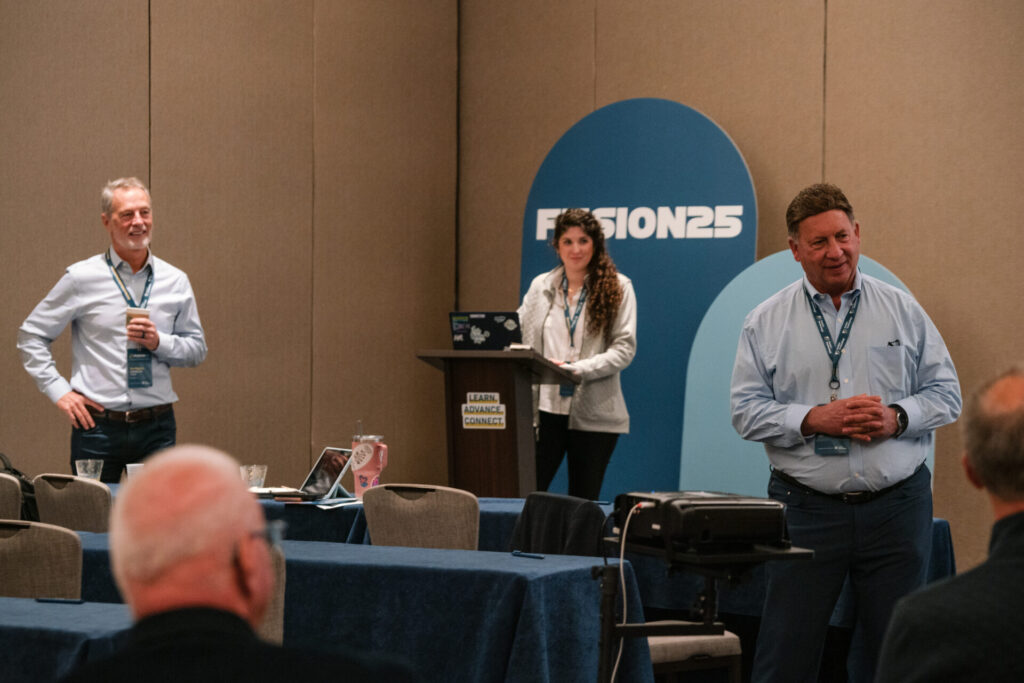
If you’ve ever had to convince a facility owner/operator (or your own team) that your idea is worth the money, time and headspace – then this FUSION25 session recap is for you.
In this session, Parker Technology’s CFO, Brian “Mo” Modiano and Tim Maginn, Principal of Certitude, LLC, joined forces to walk us through their tried-and-true “ROI Playbook.”
The main takeaway: ROI is not just about the math. It’s about alignment, clarity and creating a culture that thinks about value.
ROI Is More Than Math – It’s a Language
We all know the basic ROI equation: (Gain from Investment – Cost of Investment) / Cost of Investment. Easy, right?
But Mo and Tim challenged us to think bigger. They argued that ROI isn’t just a financial tool. It’s a common language. A framework for smart decision-making that teams across your org can rally around.
“Used correctly, ROI becomes kind of a powerful alignment tool within your organization. It’s not just a financial metric. It’s a way of thinking, it’s a way of managing, it’s a way of communicating,” said Tim.
Why does that matter? Because too many organizations make decisions on the fly, without alignment, data or clear communication.
When the ROI model is used consistently, it helps teams move faster (with confidence), gain buy-in and avoid costly missteps.
The Hidden Power of Holistic Thinking
Tim shared that most teams only look at surface-level numbers. But ROI done right means zooming out and evaluating the full impact of a decision, including those “soft costs” like employee stress, training time or customer satisfaction.
He gave an example. One organization rolled out AI tools to better support frontline staff. The math on paper looked perfect. In practice? Hiring costs shot up, onboarding slowed down and employee morale took a hit. The lesson: Always look at both the numbers and the people side of change.
Teaching Teams to Think in ROI
A major theme in this session was “building a culture of ROI fluency.”
Mo and Tim encouraged leaders to help their teams not just build ROI models, but confidently defend them. When people can articulate their assumptions, challenge each other’s math and stress-test their ideas, that’s where real alignment happens.
“Whatever you see here, it’s not going to unfold exactly this way. It’s really important that you have different levers for things that might change and do the scenario planning. That’ll give you a more holistic view,” said Mo.
They also emphasized that ROI models aren’t one-and-done. Market conditions change, and so should your model.
They even recommended celebrating when a team decides not to pursue an initiative because the ROI doesn’t check out.
“Part of the culture and coaching for your teams is to say congratulations on making the decision to kill that one. The data that you put together shows you made the right decision not to proceed,” said Tim.
That kind of decision is just as valuable as a “yes.”
Real-Life Use Cases from the Parking World
Mo walked through a few real-world examples, including one from a large operator using Parker Technology’s services. The topline numbers showed a $17,000 monthly invoice, but factoring in revenue recapture from Parker Technology’s call resolution services cut that cost dramatically. Depending on average ticket price and volume, the “real” cost per hour dropped as low as $0.60. Now that’s some ROI magic.
Another standout case study came from The University of Southern California. After partnering with Parker and integrating with their PARCS equipment, they reduced revenue leakage by more than $14,000/month. That’s 5X ROI compared to what they were paying Parker.
Better Service = Better ROI
Don’t underestimate the impact of customer experience. It’s one of the most powerful (and often overlooked) ROI drivers in your operation.
Mo reminded us that when service falls short, the cost goes far beyond one unhappy customer. In fact, according to the U.S. Chamber of Commerce, 68% of customers leave because of poor service. That kind of churn quietly chips away at your long-term revenue and brand equity.
But the ripple effect doesn’t stop there. Those dissatisfied customers talk – to friends, online reviews and social media – and that negative buzz can multiply your losses.
“Quality service matters because it impacts your churn. It will impact you in the long term if you’re not providing that to your customers,” said Mo.
Bottom line? Quality isn’t just a “nice to have.” It’s a strategic lever that directly affects your bottom line. When service improves, so does ROI.
Final Thoughts
To wrap it all up, Tim said it best, “ROI isn’t just the product of a spreadsheet. It’s a mindset. It’s a tool that helps teams slow down, align around the “why” and ultimately make better, faster decisions.”
So, the next time someone on your team pitches an idea, don’t just ask “What does it cost?” Ask, “What’s the return?” Better yet, hand them the ROI Playbook and build a culture that thinks, plans and leads with value.
Because great decisions aren’t just good guesses – they’re good math.
Want more insights from FUSION25? Stay tuned for more session recaps and stories from the people building excellence.

Katelyn Perman
Content Marketing Manager
Katelyn Perman has 4+ years of experience in marketing, specializing in social media strategy, email campaigns, graphic design and copywriting. She holds a B.S. in Strategic Communication and Human Communication Studies from Indiana Wesleyan University.
